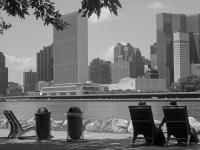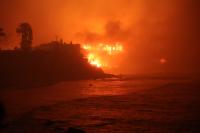Kugayama South Gate Building
Tokyo, Japan
The Area - Commuter Town with Hints of Water and Greenery
The building is located in the west part of central Tokyo, in the immediate vicinity of Kugayama station. The area is rimmed with greenery, showing remembrances of a hilly countryside from the past. To the south of the station there are waterways like Kanda River and Tamagawa Aqueduct, and to the north there is a trace of an old pilgrimage trail. The site faces the very gateway to an attractive shopping lane, opening its two sides to the public.
Starting Point - Realising Different Values
One of the key demands for a modern commercial building is to maximise profit by compressing common space and make way for as much tenant area as possible.
On the other hand, analysis showed that underneath modern-day cityscape there had been generations of water-green-people relationship. Finding out how our new building could communicate with this site's uniqueness was the starting point of the design. We aimed at synchronising these different values in one commercial building.
Design Insight - Rebuilding Relationship with Water
Modern rapid development of suburbs has covered the ground with concrete and transformed rivers into nothing more than huge ditches. Water level is too unstable for the natural habitat to grow, and no one reaches the water, no one befriends the river any more. Apparently, we miss the way we had previously interacted with water. We miss balance and beauty mother nature originally had.
There is one symbolic shape in nature - found everywhere in the course of water cycle - a tree shape. Branches, roots, veins, rivers, roads... Tree shapes are universal solutions of nature to reach as much area as possible while minimizing resources. Another advantage is that only a simple set of codes is enough to realise a complex system, because the shape itself is a fractal. Our solution is to take that shape onto our building, not only as an icon, but as an integral and functioning part of large-scale water cycle that will grow over time and blur the boundary between art and nature. This will best symbolize visions of nature-loving people.
The Design - Growing into the Town
The building's facade is characterised by the combination of two main elements - aluminum panels and tree shapes. Aluminum cladding has special luster that reflects the town's ever-changing ambience in different times of day or weather to blend the new building in this mature townscape while showing prospect to the coming ages.
Iconic tree shapes work as rainwater drain, support for plants and at night, as lighting.
The shapes comprise H beams as trunks, pipes as branches and wires for plants. These shapes provide multiple routes of rainwater drainage to minimise roof slab height and maximise rental space. Rainwater flows along the sides of H beams into the basement reservoir. It is pumped up for reuse in the building like as irrigation for the plants, and then let go in controlled penetration or drainage until it reaches the river. By using the rainwater drain as main part of facade design, we aimed at change of values. By openly showing the rainwater - in a symbolic shape of natural water cycle - we strongly visualise how the building works as integral part of that cycle. Town's people will now be able to enjoy rainwater again.
The tree shapes will evolve over years as the plants grow over them. In time the building will be a continuous part of the town's loved greenery. We also enclosed the windows with these shapes to present indoor activity in green frames, in hope of attracting green-friendly tenants. We expect to see the changes for the better this little experiment will bring to the townscape.
- Architects
- Ryuichi Sasaki Architecture
- Location
- 杉並区久我山2-16-24, Tokyo, Japan
- Year
- 2017
- Client
- SHINKOSHOJI
- Team
- RYUICHI SASAKI, GEN SAKAGUCHI, ANNA KWAPIEN, YURIKO OGURA
- 施工
- マゴメ工務店
- 照明デザイン、照明メーカー
- ライティング創
- アルミ光輝材
- 新光ステンレス研磨
- 雨樋
- タニタハウジング













